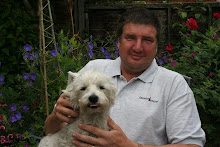 |
| Picture by Leah Burgess, used with permission. |
One thing that surprises and delights us about our move to rural Ireland (from urban Kent) is the clear, unpolluted air and almost complete absence of light pollution so that our night skies are more spectacular than we even dreamed of in Kent. Better too than I remember from anywhere else I have lived. I was used to us being able to see Orion and The Plough if we were lucky, but now we can see so many gazillions of smaller stars on a clear night that it can actually be difficult to pick out those well known constellations. We can see the Milky Way from here, a feature I think I never saw in Kent.
 |
| Spider web in the Bramley tree catching some evening sun. |
These 'Nights of a Million Stars' (as we call them) used to be a feature of our nights spent in the caravan during the house build; we'd wander out of the caravan to use phones or for a 'comfort stop' , to have our bonfires or to get out of the way while meals were being cleared away or the furniture re-arranged from seats into beds. To start with we had no electricity, so 'light' was candles or oil lamps in the caravan, the 'grounds' were black-dark and the stars massed above just shouted out to be gazed at in wonder.
 |
| Quince tree doing very well. No fruit yet but plenty of growth. |
So our minds are always alert for interesting 'space' and astronomy stories to follow up - internet posts about the International Space Station, interesting planetary conjunctions, the solar eclipse earlier in the year (OK, that was a daytime one), unusually large or bright moons, comets, the Northern Lights and so on. We are always game for a middle-of-the-night alarm call and a dressing-gown clad wander round the dark front garden with binoculars, cameras and a mug of coffee. This week's full Lunar Eclipse coincident with the moon being close to Earth (a "super moon") was right up our street. The promise of clear, high-pressure skies was the icing on the cake.
 |
| 'Feste' chops smeared with mushed up garlic, lemon juice and salt. |
It did not disappoint. The alarm woke me at 03:00 as the proper moon light was just about to fail, shoved aside by the Earth's shadow. Liz had actually stayed awake reading, so was already 'up'. We watched while the light winked out and the blood-red colour washed across the moon. We both tried to take pictures but neither of us have a camera capable of such a shot (Liz only has her phone and with my trusty Canon EOS trying to die on me, I am on a tiny Sony Cybershot - it works OK on the 'holiday snaps' pics in this blog but correctly illuminating the moon and zooming in the 100x you'd need are way beyond it). I am grateful to Leah Burgess who gave me permission to use her composite multi-exposure shot at the top of this post.
 |
The heather is well out in the Kiltybranks bog dog-walk
where the 2 new wind turbines now add to the skyline. |
We sat and watched the action for a good 45 minutes including gazing around at all the other stars and the Milky Way and had the added bonus of three separate meteors streak through the field of view and I saw a bat. We were joking that we only needed the ISS to wander over, an owl to hoot or the young fox I saw on the lawn the previous night to stroll through, and we would have the complete night-shift 'Bingo' card filled in. The blood-red thing was due to go on for a couple of hours and we soon decided that a dog-patrol and a cup of coffee would see us well enough eclipsed and we went off to bed happy star-gazers all. I did look out a few hours later and was happy to see that the moon was filling back up with 'proper' light as the earth's shadow moved away and the eclipse was done for 18 years or so.
 |
My plucky little 'Stihl 025' chain saw gets its big-boy pants
on to start slicing up the fallen black spruce. |
Meanwhile life is turning quite autumnal here and I have been getting into some serious logging and started preparing to 'winterise' the bees. With the log store over half full now of the ash I coppiced out of the pig-run and the rubbish and old fence posts gathered from all about the place as we clear more and more 'jungle', I needed to move on to the big 55' black spruce which came down in a gale last November. This was a daunting task as my little Stihl chainsaw would struggle to cut a tree this thick and I was looking at several hours of sweaty, back-aching work just to slice it up, never mind splitting it with the axe. These trees have many side branches, so many of the rounds you slice out of the trunk are badly knotted and can be hard to split.
 |
The 'cavalry' made short work of the rest of the bole - this took
my helper about 45 minutes with his bigger saw. |
Fortunately I had got talking to a very helpful lad down our lane who has a selection of bigger saws and had agreed to come and help. Unfortunately, I knew, he had ricked his back a week or so ago and might not be available, so I had decided to make a start. I did this yesterday (Sunday) determined to run the saw out of all the petrol I had on site and just see how I got on. That proved to be about an hour and a half and I sliced no more than a dozen rounds; about 12 feet of tree.
 |
53 tree-rings in this bottom slice which is 2 feet diameter
and 5' 7" circumference. That makes Vendor Anna's estimate
of a 1963 planting date just about spot on. |
I was delighted today, then, when my man breezed in and hefted a 20 inch cut machine out of his car boot, fired it up and started slicing my tree like a hot knife cutting through butter. He happily gave me a running commentary at every stop (for fuel etc) about how to keep a saw in good nick, what was a good saw in the first place, where to have them serviced and what might be wrong with mine or my technique. It took him all of about 45 minutes to slice up the remaining 30-40 feet of tree including, obviously, the way thicker stuff at the bottom. The final slice before the root-splay was 2 feet diameter and 5 feet 7 inches circumference and the 53 tree rings make Vendor Anna's 1963 planting date estimate (by her Dad when she was a little girl) pretty much spot on. Either way it's quite a growth rate for little saplings put in to make a wind break round the veg patch! As an added bonus (again) the lad also offered to take my own saw away and give it a "proper" sharpen.
 |
The oiled wooden square frame here is an 'eke'. The cut out
square of house insulating foam will slot in to make a cosy
warm layer of 'loft insulation' for the hive |
Finally, those bees. They are out among the heather at the moment which is in flower all around the bogs and will soon move on to ivy as that comes into flower. Both these honeys are difficult for the honey-producing bee keeper; the heather honey sets as a 'gel' like tomato ketchup which will not flow and has to be pressed out of the comb with, for example, a cider press. Technically it is "thixotrophic". The ivy honey sets like rock! Bee keepers will generally whip off the honey stores they intend to harvest by about now before the heather honey starts and move hives back 'home' from the hills, starting to snug them down for winter.
 |
Young 'Solo' at 3 months starts copying Dad's tail-up,
wings down display style. |
Readers who were with me in April will recall that we lost our last year colony because, we believe, we left them too much space within the hive and the little young colony could not keep the cluster warm enough. They died of hypothermia. We are determined that this will not happen again. We have already removed the spare (empty) 'super' so there is no fresh air above the cluster and we know they have filled the frames to all 4 corners of the brood box and first super. I am going to provide them with a 3 inch thick sheet of insulating foam as 'loft-lining' and slide the varroa-mite counting board into the slot in their floor to reduce drafts from the bottom.
 |
.Buildering' again and my trusty pointy-shovel
seemed to enjoy the feel of the familiar '804'
gravel we moved so much of during our own
building adventures. |
This is all a bit radical and the bees would not be impressed by suddenly being made THAT warm if the sun was still beating down, but if I wait till the current burst of lovely autumn sunny weather is done it should all work and the bees should have no trouble keeping their interior at the required 34ºC. I will take all this extra protection off again come April or so when the temperatures come back up towards 14ºC outside and the bees start exploring again. The count-board also gives me a chance at this late stage to double check the varroa infestation level, which was so wonderfully low when I checked in summer.













No comments:
Post a Comment